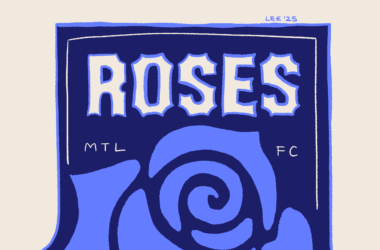From teen movies to major league sports, cheerleaders often attract a specific kind of attention, and it isn’t always based on their athleticism. The figure of the cheerleader, in these popular representations, seems to overshadow the actual sport of cheerleading. In reality, McGill cheerleading, a self-funded competitive club, is one of many competitive cheerleading teams where respect for the sport comes above all else.
“Our practices are completely dedicated for us to train for competitions,” three-year McGill cheerleading veteran Gabrielle Cloutier said. “That’s the one thing about cheer; people just see us at football games and they think that’s what cheer is all about, but really it’s way more intense.”
The team practices two to three times per week, with additional practices near competitions, which occur a few times a semester. If you’ve seen McGill cheerleading at basketball or football games, you’ve only seen their warm-up. This semester, the team is training for a competition in Montreal on Nov. 19 and then Power Cheerleading Association Nationals in Brampton, Ontario on Nov. 25.
“[Cheering at a game] reinstates the basics we have,” third-year cheerleader Courtney Macdonald said. “We never do anything super difficult at the games because of the conditions [of the venue].”
Beyond games and practices, being a part of McGill cheerleading also means taking on the responsibility of fundraising for the team. The cheerleaders do everything from weekly samosa sales, to odd jobs, to performance gigs in the St. Patrick’s day parade in order to cover the team’s costs. These costs include renting practice space in a suitable gymnastics gym, coaches’ salaries, and travelling to competitions. The amount of fundraising required can be a lot for those new to the team.
“People don’t realize [the commitment], going into cheerleading […] they think that it’s going to be a side thing,” Cloutier said.
Because of these extra requirements, being a McGill cheerleader demands a high level of mental involvement. Aside from fitness and athleticism, spirit is also an important concept in cheering. The team members apply this idea to the way they approach their dedication to cheer and perseverance through challenges.
“I remember [the old team captain] telling me that there’s nothing that’s as much of a team sport than cheer is,” Cloutier said. “You have to be 100 per cent all of the time, because if you’re not there, someone’s going to get hurt. That’s where spirit comes in. If you’re on the mat and your stunt just fell and you have to keep going to your other stunt, having those voices telling you to keep going is crucial.”
This presence of mind comes in large part from synergy with teammates.
“I never used to be the most spirit-ful person but since being on the team, it’s so easy to be [spirited],” Macdonald said. “When we take the mat we feed off each other’s energy.”
An added difficulty of cheering is managing people’s misconceptions of the sport, and of cheerleaders in general. These notions range from the idea that cheerleaders are catty and shallow, to the idea that cheering is complementary entertainment, rather than a sport in and of itself.
“We’re not the only [cheer] team dealing with that at all,” Cloutier said. “Even if you’re a complete all-star team that doesn’t even cheer at football games, you’re going to have [to face] that perception.”
Cloutier, a former competitive dancer, and Macdonald, a retired national gymnast, both emphasized that, despite common television portrayals, cheer competitions have less rivalry than other sports they’ve been involved in.
“The sport is respected so much that when the other team sees another team doing a stunt that is brand new or really hard to execute you’re going to cheer them on so much,” Cloutier said. “The drama you see in the movies, […] that’s completely absent.”

(Gabriel Helfant / The McGill Tribune)
As for the notion that cheering is sideline entertainment, Macdonald explains that anyone who is familiar with competitive cheerleading understands the extreme dedication, physical strength, and risk-taking it requires.
“We do a lot of conditioning, strength training, so that we can be 100 per cent to catch the girls,” Macdonald said.
Strength is a requirement while executing such physically demanding maneuvers. Everyone on the team understands the potential for injury if someone falters during a stunt.
“We have this rule that if our flyer [the girl thrown in the air] touches the mat, everyone does 50 push ups,” Cloutier added.
This year, try-outs were opened to male cheerleaders for the first time in a decade. Being coed would put the team in a different league, allow for new stunts to be performed, and help manage some of the stigma of being an all-girl cheer team. The team started the year with two males, but after a few weeks, they dropped off due to the high level of involvement.
“I think the fact that we went from being coed to all girl was our biggest challenge this semester,” Macdonald said. “We had to change the routine that our coaches had already started forming, and I think that for some people it was a hit to their morale.”
However, both Macdonald believes that the challenge has ultimately made the team stronger.
“I think we’re happier as all-girl right now,” Macdonald said. “The obstacle of going from coed to all girl has gotten to us where we are today.”
After months of bonding and overcoming obstacles, teammates can now fully rely on one another.
“Right now, we’re at that point in the season where everybody who’s here is here to stay,” Cloutier said.
With so much physical and mental energy put toward making the team possible, both Macdonald and Cloutier wish the McGill community had a greater awareness of McGill Cheer. Not just for their role in cheering on other McGill teams, but for the level of athleticism the team works toward themselves, and the rigorous competitions they participate in.
“We’re fully competing, throwing very dangerous and cool skills,” Macdonald said.
Furthermore, cheerleading goes far beyond entertainment; as McGill cheerleading demonstrates, the team trains and competes as varsity-level athletes.
“We’re here and we’re a competitive sport,” Cloutier concluded.









